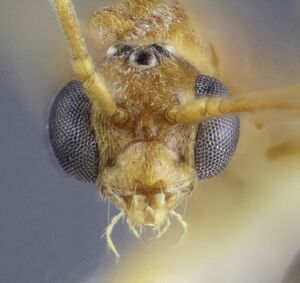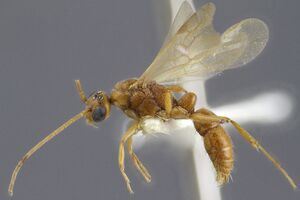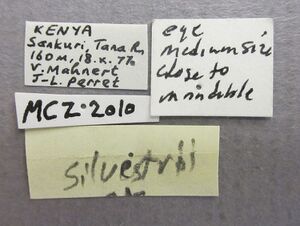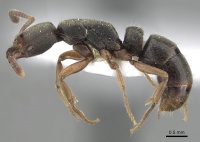Bothroponera silvestrii
| Bothroponera silvestrii | |
|---|---|

| |
| Scientific classification | |
| Kingdom: | Animalia |
| Phylum: | Arthropoda |
| Class: | Insecta |
| Order: | Hymenoptera |
| Family: | Formicidae |
| Subfamily: | Ponerinae |
| Tribe: | Ponerini |
| Genus: | Bothroponera |
| Species group: | sulcata |
| Species: | B. silvestrii |
| Binomial name | |
| Bothroponera silvestrii Santschi, 1914 | |
| Synonyms | |
| |
The wide range distributions of B. silvestrii in East Africa reflects its ability to inhabit various habitats with various ecological conditions. Robertson (1995) studied specimens from Tanzania collected from dry forests (1600m) below a mountain summit, with the ants found in sheltered areas under rocks among leaf litter. Bhoke and Richard (2007) hand collected specimens, also from Tanzania, in primary forest at 700m. (Joma and Mackay 2017)
Identification
Worker – A member of the Bothroponera sulcata species complex. The main distinguishing character of B. silvestrii is the dorsum and sides of the head lacking or nearly lacking erect hairs. The surfaces of pronotum, propodeum, petiole and postpetiole are hairy and they are ants (total length 5.25 - 7.05 mm). The anterior medial margin of the clypeus has a single medial longitudinal raised area that forms a smooth shiny longitudinal groove. The mandibles are smooth, shiny and have about 6 to 7 teeth. The compound eyes are relatively small.
The head, pronotum, propodeum, petiole and postpetiole are roughly sculptured with foveolae, without punctures, dull. The head, pronotum and propodeum are dull, the petiole and postpetiole weakly shiny. The legs and antennae are moderately shiny.
The pronotal humerus is rounded anteriorly. The propodeum is subquadrate, with the latero- and dorsopropodeum forming an obtuse angle with the posteropropodeum. The basalar sclerite is rounded. The posteropropodeum is mostly straight, not concave, and slopes gradually to reach the connection with the petiole. The petiolar node height is the same as the height of the dorsopropodeum, but slightly higher than the postpetiole. The petiole is rounded anteriorly and slightly concaves posteriorly (side view).
The entire body is covered with fine hairs. Erect hairs are present on the mesosoma, petiole, postpetiole and 4th to 7th abdominal segments, except on the posterior border of head where there are a few scattered erect hairs from 0.02 to 0.12 mm. The entire body is mostly brown to brownish black; the legs, clypeus, mandibles and antennae are light brown.
Bothroponera silvestrii can be separated from the other species of the Bothroponera crassa species complex by the higher density of hair on most surfaces, by the anterior raised area of the clypeus, by the relatively small total length of the clypeus, by the relatively small total length and the lateropropodeal shape. It is easy to separate Bothroponera picardi from B. silvestrii because B. picardi is characterized by the bare surface (without erect hairs).
The clypeus is completely different from most other species, in B. silvestrii as it is covered with fine hairs and the medial raised area forms a flat longitudinal region while in B. crassa, Bothroponera ilgii and B. picardi the medial raised area of clypeus forms a smooth shiny groove, a completely or partially striated raised area as in Bothroponera soror or forms a tiny depression at the lower part of the narrowed strip, and a smooth shiny raised area of the clypeus as in Bothroponera kruegeri. Bothroponera silvestrii, B. ilgii, B. kruegeri, B. picardi, B. crassa, Bothroponera ancilla, Bothroponera notaula, Bothroponera ryderae, Bothroponera pilosuperficia and B. soror all have the same convex clypeus that has an anterior raised area that forms a longitudinal smooth shiny narrowed strip. The raised anterior area generally forms a smooth shiny longitudinal wide groove in the B. ryderae, forms a slight groove or is without groove in B. silvestrii, B. ilgii, B. picardi and B. crassa. In B. soror this character covered completely or partially with striae while in B. kruegeri this area tends to lack a groove more sculptured rather than smooth.
The members of the B. crassa species complex have a smallest length range from 5.25 mm – 7.05 mm e.g. in B. silvestrii and the largest length from 11.75 mm - 12.55 mm e.g. in B. kruegeri. The total length of B. silvestrii overlaps the dimensions with other species including B. picardi 6.30 – 6.50 mm, B. crassa 6.00 - 8.80 mm. B. ryderae 6.55 - 7.20 mm and B. ancilla 6.75 - 8.90 mm. The species with largest total length compared to B. silvestrii include B. soror 7.60 - 11.10 mm, B. notaula 7.60 mm, B. pilosuperficia 7.50 - 9.00 mm, B. kruegeri 11.75 - 12.55 mm and B. ilgii 8.05 - 9.40 mm.
The form of the lateropropodeum is an obvious character to separate B. silvestrii from B. crassa. It is concave (from the top) in B. crassa while it is convex in B. silvestrii. Furthermore, it is easy to recognize B. silvestrii because it has small eyes (EW 0.10 - 0.25, EL 0.20 - 0.25 mm) as compared to the larger eye in B. crassa (EW 0.20 - 0.30, EL 0.30 - 0.40 mm), B. ilgii (EW 0.30 - 0.35, EL 0.40 - 0.45 mm), B. notaula (EW 0.25, EL 0.40 mm) and B. kruegeri (EW 0.40 - 0.45, EL 0.50 - 0.70 mm).
Male The total length is 4.70-5.10 mm. The head is suborbiculate. The medial ocellus is relatively small (0.12-0.13 mm). The scape is shorter (0.20 mm) and thicker than the second funicular segment (0.27 mm), twice the length of the pedicel (0.10 mm). The compound eyes are large (width 0.30-0.35 mm, length 0.50mm), and cover most of the sides of the head.
The pronotum is square laterally and rounded anteriorly. The pronotal humerus is rounded. The notauli are present and meet at a point medially on the scutum. The scutellum is subtriangular and elevated in lateral view. The metanotum separates the scutellum and propodeum with a medial sharp carina. The mesopleuron is divided by the anapleural sulcus to form the infra katepisternum and supra anepisternum. The metanepisternum is well developed and distinguished from the propodeum and mesopleuron while the metakatepisternum is narrow and poorly developed. The meso-metapleural suture is very distinct. The propodeal spiracle is elongated. The dorsopropodeum gradually slopes posteriorly to reach the insertion point of the petiole. The petiole is small, with a rounded apex and the width is less than the width of propodeum; the height is less than that of the postpetiolar height. The postpetiole is rounded anteriorly. The head, pronotum, scutum, scutellum, propodeum, petiole and postpetiole are roughly sculptured.
The entire body is covered with fine short (less than 0.02, - up to 0.05mm) dense hairs. The dorsum of the scutellum, metanotum, propodeum, petiole and postpetiole are covered with scattered and moderately short hairs (0.20-0.25 mm). The hairs on the suture between the pronotum and scutum are moderately short. The hairs on the dorsum of the scutellum, petiole and ventral surface of the postpetiole are denser and longer than on the other body parts.
The body color is mostly yellow to light brown.
The male of B. silvestrii can be compared with the available males of B. crassa, B. ilgii, B. kruegeri, B. notaula, B. ryderae and B. soror. The B. silvestrii male has a total length about 4.70 - 5.10 mm, which is the smallest total length among the other males of the Bothroponera sulcata species complex which have larger total lengths (5.60 - 10.25 mm). The metanotum of B. silvestrii is elevated between the scutellum and propodeum and forms a medial sharp carina. This carina is not present in B. soror, B. kruegeri, B. notaula, B. ryderae, B. ilgii and B. crassa.
Keys including this Species
Distribution
Cameroon, Ghana, Guinea, Ivory Coast, Nigeria, Kenya and Tanzania. (Joma and Mackay 2017)
Latitudinal Distribution Pattern
Latitudinal Range: 8.266667° to -11.00842°.
| North Temperate |
North Subtropical |
Tropical | South Subtropical |
South Temperate |
- Source: AntMaps
Distribution based on Regional Taxon Lists
Afrotropical Region: Cameroun, Ghana (type locality), Guinea, Ivory Coast, Kenya, Nigeria, United Republic of Tanzania.
Distribution based on AntMaps
Distribution based on AntWeb specimens
Check data from AntWeb
Countries Occupied
| Number of countries occupied by this species based on AntWiki Regional Taxon Lists. In general, fewer countries occupied indicates a narrower range, while more countries indicates a more widespread species. |

|
Estimated Abundance
| Relative abundance based on number of AntMaps records per species (this species within the purple bar). Fewer records (to the left) indicates a less abundant/encountered species while more records (to the right) indicates more abundant/encountered species. |

|
Biology
Castes
Images from AntWeb

| |
| Worker. Specimen code casent0317061. Photographer Shannon Hartman, uploaded by California Academy of Sciences. | Owned by CAS, San Francisco, CA, USA. |
- Male
   
| |
| . | Owned by Museum of Comparative Zoology. |
Nomenclature
The following information is derived from Barry Bolton's Online Catalogue of the Ants of the World.
- silvestrii. Pachycondyla (Bothroponera) silvestrii Santschi, 1914d: 313 (w.) GHANA.
- Type-material: 2 syntype workers.
- [Note:Baroni Urbani, 1973b: 134, cites 1w syntype NHMB.]
- Type-locality: Ghana (“Gold Coast”): Aburi (F. Silvestri).
- Type-depository: NHMB.
- [Note: second syntype perhaps in Silvestri collection DEUN.]
- Joma & Mackay, 2017: 39 (m.).
- Combination in Pachycondyla: Brown, in Bolton, 1995b: 309;
- combination in Bothroponera: Wheeler, W.M. 1922a: 72; Schmidt, C.A. & Shattuck, 2014: 77.
- Status as species: Wheeler, W.M. 1922a: 772; Bolton, 1995b: 309; Joma & Mackay, 2017: 39 (redescription).
- Senior synonym of kenyensis: Joma & Mackay, 2017: 39.
- Senior synonym of nimba: Joma & Mackay, 2017: 39.
- Distribution: Cameroon, Ghana, Guinea, Ivory Coast, Kenya, Nigeria, Tanzania.
- kenyensis. Bothroponera kenyensis Santschi, 1937a: 47, figs. 1-3 (w.) KENYA.
- Type-material: holotype worker.
- Type-locality: Kenya (“Kenya Colony”): (no further data).
- Type-depository: BMNH.
- Combination in Pachycondyla: Brown, in Bolton, 1995b: 306;
- combination in Bothroponera: Schmidt, C.A. & Shattuck, 2014: 77.
- Status as species: Bolton, 1995b: 306; Hita Garcia, et al. 2013: 220.
- Junior synonym of silvestrii: Joma & Mackay, 2017: 39
- nimba. Bothroponera silvestrii r. nimba Bernard, 1953b: 188 (w.) GUINEA.
- Type-material: 12 syntype workers.
- Type-locality: 9 workers Guinea (“French Guinea”): Nimba Mts, Mt Nion, relevé D (Savane de Keoulenta), 500 m., au relevé E (no collector’s name), 3 workers Guinea: (no further data, “sans localité précise”).
- Type-depository: MNHN.
- Combination in Pachycondyla: Brown, in Bolton, 1995b: 307;
- combination in Bothroponera: Schmidt, C.A. & Shattuck, 2014: 77.
- Subspecies of silvestrii: Bolton, 1995b: 307.
- Junior synonym of silvestrii: Joma & Mackay, 2017: 39.
Unless otherwise noted the text for the remainder of this section is reported from the publication that includes the original description.
Description
Worker
Joma and Mackay (2017) - (n=25), HL 1.10 - 1.25, HW 0.95 - 1.10, ML 0.50 - 0.70, EW 0.10 - 0.20, EL 0.15 - 0.25, SL 0.75 - 1.05, FL 1.15 -1.70, WL 1.45 - 1.90, WPL 1.80 - 2.40, PL 0.40 - 0.50, PW 0.60 - 0.70, PH 0.60 - 0.80, CI 86.36 - 88.00, OI 15.78 - 22.72, Mandl 45.45 - 56.00, SI 78.94 - 95.45, Peti 140.00 - 150.00. Measurements of Bothroponera nimba: HL 1 .25, HW 1 .05 - 1 . 1 0, ML 0.65 - 0.75, EW 0. 1 5 - 0.20, EL 0. 1 5 - 0.20, SL 0.95, FL 1 .35 - 1 .50, WL 1.35 - 1 .85, WPL 2.20 - 2.35, PL 0.45, PW 0.60 - 0.65, PH 0.75 - 0.80, CI 84.00 - 88.00, OI 14.28 - 18.18, Mandl 52.00 - 60.00, SI 86.36 - 90.47, Peti 133.33 - 144.44. Measurements of Bothroponera kenyensis: HL 1.20 - 1.50, HW 1.05 - 1.25, ML 0.65 - 0.75, EW 0.10 - 0.25, EL 0.20 - 0.25, SL 1.00 - 1.10, FL 1.65 - 1.85, WL 1.75 - 2.25, WPL 2.20 - 2.60, PL 0.45 - 0.60, PW 0.65 - 0.70, PH 0.70 - 0.90, CI 83.33 - 87.50, OI 19.04 - 20.00, Mandl 50.00 - 54.16, SI 88.00 - 95.23, Peti 144.44 - 116.66. Head square; clypeus covered with fine hairs, medial area raised to form basal sculptured region, apical region forms triangular smooth area without groove; malar space length 0.15 mm, area from upper edge of eye to upper margin of posterior lobe 0.60 - 0.65 mm; entire body covered with fine dense hairs (0.02 mm) mixed with short (0.10 - 0.30 mm) erect golden hairs scattered on dorsum of pronotum and propodeum; pronotal humerus; dorsum of pronotum, propodeum, petiole and postpetiole covered with few and moderately short (0.10 - 0.20 mm) erect scattered hairs, up to 0.30 in some specimens; hairs denser on ventral surface of postpetiole; hairs on ventral surface of head few and short (0.15 - 0.25 mm); short erect hairs (0.02 - 0.05 mm) on head, pronotum, propodeum, petiole and postpetiole dark brown or reddish brown. Mandibles brown or reddish brown, legs and antennae brown. Body reddish brown in some specimens; petiole and postpetiole dark brown, legs, antennae, clypeus and mandibles brown.
Male
Joma and Mackay (2017) - (n=2), HL 0.75 - 0.80, HW 0.45 - 0.50, ML 0.20 - 0.25, EW 0.30 - 0.35, EL 0.50, SL 0.20, FL 3.10, WL 1.55 - 1.60, WPL 2.00 - 2.05, PL 0.45, PW 0.40 - 0.45, PH 0.50 - 0.60, CI 60.00 - 62.50, OI 100.00- 111.11, Mandl 26.66-31.25, SI 40.00 - 44.44, Peti 88.88 - 100.00. Ocelli small; moderately short hairs (0.20 - 0.25 mm) scattered on dorsum of scutellum, metanotum, propodeum, petiole, postpetiole and on suture between pronotum and scutum; hairs on dorsum of scutellum, petiole and ventral surface of postpetiole denser and longer than on other body parts; color mostly yellow and light brown.
References
- Brown, W. L., Jr. 1995a. [Untitled. Taxonomic changes in Pachycondyla attributed to Brown.] Pp. 302-311 in: Bolton, B. A new general catalogue of the ants of the world. Cambridge, Mass.: Harvard University Press, 504 pp. (page 309, combination in Pachycondyla)
- Esteves, F.A., Fisher, B.L. 2021. Corrieopone nouragues gen. nov., sp. nov., a new Ponerinae from French Guiana (Hymenoptera, Formicidae). ZooKeys 1074, 83–173 (doi:10.3897/zookeys.1074.75551).
- Joma, A.M.A. & Mackay, W.P. 2017. Revision of the African ants of the Bothroponera sulcata species complex (Hymenoptera: Formicidae: Ponerinae). Transactions of the American Entomological Society. 143:7-71.
- Joma, A.M.A., Mackay, W.P. 2020. Revision of the African ants of the Bothroponera talpa species complex (Hymenoptera: Formicidae: Ponerinae). Transactions of the American Entomological Society 146: 355-408. (doi:10.3157/061.146.0206).
- Santschi, F. 1914d. Formicides de l'Afrique occidentale et australe du voyage de Mr. le Professeur F. Silvestri. Boll. Lab. Zool. Gen. Agrar. R. Sc. Super. Agric. 8: 309-385 (page 313, worker described)
- Schmidt, C.A. & Shattuck, S.O. 2014. The higher classification of the ant subfamily Ponerinae (Hymenoptera: Formicidae), with a review of ponerine ecology and behavior. Zootaxa 3817, 1–242 (doi:10.11646/zootaxa.3817.1.1).
- Wheeler, W. M. 1922b. Ants of the American Museum Congo expedition. A contribution to the myrmecology of Africa. II. The ants collected by the American Museum Congo Expedition. Bull. Am. Mus. Nat. Hist. 45: 39-269 (page 72, Combination in Bothroponera)
References based on Global Ant Biodiversity Informatics
- Bernard F. 1953. La réserve naturelle intégrale du Mt Nimba. XI. Hyménoptères Formicidae. Mémoires de l'Institut Français d'Afrique Noire 19: 165-270.
- Braet Y., and B. Taylor. 2008. Mission entomologique au Parc National de Pongara (Gabon). Bilan des Formicidae (Hymenoptera) recoltes. Bulletin S. R. B. E./K.B.V.E. 144: 157-169.
- Joma A. M. A., and W. P. MacKay. 2017. Revision of the African ants of the Bothroponera sulcata species complex (Hymenoptera: Formicidae: Ponerinae). Transactions of the American Entomological Society, 143(1): 7-71.
- Levieux J. 1972. Etude du peuplement en fourmis terricoles d'une savane preforestiere de Cote d'Ivoire. Revue d'Ecologie et de Biologie du Sol 10(3): 381-428.
- Levieux J., and T. Diomande. 1985. Evolution des peuplements de fourmis terricoles selon l'age de la végétation dans une foret de Cote d'Ivoire intacte ou soumise à l'action humaine. Insectes Sociaux 32(2): 128-139.
- Lévieux J. 1972. Les fourmis de la savane de Lamto (Côte d'Ivoire): éléments de taxonomie. Bulletin de l'Institut Fondamental d'Afrique Noire. Série A. Sciences Naturelles 34: 611-654.
- Stephens S. S., P. B. Bosu, and M. R. Wager. 2016. Effect of overstory tree species diversity and composition on ground foraging ants (Hymenoptera: Formicidae) in timber plantations in Ghana. International Journal of Biodiversity Science, Ecosystem Services & management 12(1-2): 96-107.
- Taylor B. 1976. Ants of the Nigerian Forest Zone (Hymenoptera: Formicidae). I. Ponerinae, Cerapachyinae, Pseudomyrmecinae. Cocoa Research Institute of Nigeria Technical Bulletin Series 4: 1-41.
- Wheeler W. M. 1922. Ants of the American Museum Congo expedition. A contribution to the myrmecology of Africa. VIII. A synonymic list of the ants of the Ethiopian region. Bulletin of the American Museum of Natural History 45: 711-1004
- Yeo K., S. Konate, S. Tiho, and S. K. Camara. 2011. Impacts of land use types on ant communities in a tropical forest margin (Oumé - Cote d'Ivoire). African Journal of Agricultural Research 6(2): 260-274.

